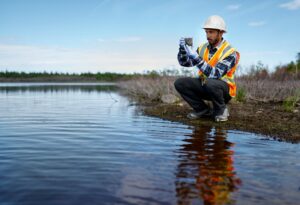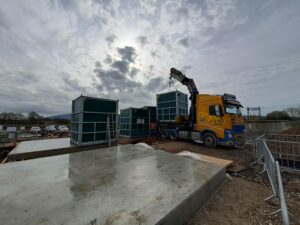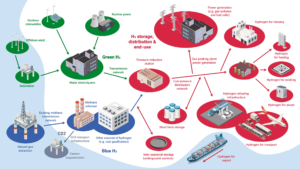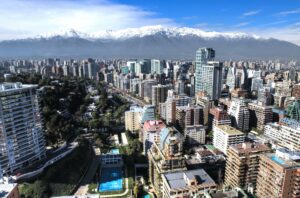[embedded content]
A UK research consortium will develop a national emissions measurement dashboard for the UK.
Led by the National Physical Laboratory (NPL), the Greenhouse Gas Emissions Measurement and Modelling Advancement (GEMMA)programme also enlists the help of Met Office, National Centre for Earth Observation, National Centre for Atmospheric Science, the University of Bristol and others. The aim is to create “a single integrated network to monitor all sources and sinks of greenhouse gases (GHGs) in the UK.”
Achieving UK GHG emission reduction targets and supporting global efforts to limit climate temperature rise is a highly complex challenge. Known and recognised sources and sinks are currently accounted for in UK net emissions. However, Earth’s climate responds to all contributions, whether known or not, which is why accurate ongoing measurement of GHG emissions in the UK is crucial – firstly, to identify their sources of origin and then to mitigate and reduce them.
GEMMA will cement a “top-down” systems approach to further complement the detail of traditional “bottom-up” inventories and provide the best available UK net emissions information.
Over the next two years, the team will research, develop and demonstrate a system which will allow the UK to measure and assess changes in atmospheric GHGs on a monthly basis. The investment in new capability will bolster efforts to improve national GHG data, which provide powerful and timely insight into the UK’s net zero transition.
Richard Barker, Head of Environment, NPL said: “Climate change is one of the biggest societal challenges of our time and the UK led the world in declaring a net zero target by 2050. The scale and complexity of net zero demands the best available information and the GEMMA programme aims is to provide the big picture, integrated view that is necessary to enable and assure that UK investment delivers.”
Tom Gardiner, Principal Research Scientist, said: “The GEMMA programme aims to use the latest developments in atmospheric measurements and modelling to determine the contributions of the different GHG sources and sinks to the overall UK inventory and how these change with time. It will be delivered through a unique collaboration that brings together key expertise from the academic and public sector research community, building on the strong UK capabilities in GHG measurement and inventory verification. The output from the two-year project will deliver a blueprint for a long-term framework to provide a detailed, measurement-based assessment of the UK’s progress towards delivering Net-Zero.”
Professor Sir Duncan Wingham, Executive Chair, NERC said: “By working collectively and leveraging new and existing investment and activity, we are harnessing the full power of the UK’s research and innovation system to tackle large-scale, complex challenges. This investment falls under the umbrella of Building a Green Future, one of five UKRI strategic themes of our five-year strategy Transforming Tomorrow Together, and aims to accelerate the green economy by supporting research and innovation that unlock solutions essential to achieving NetZero in the UK by 2050.”
Dr Alistair Manning, Met Office greenhouse gas monitoring Scientific Manager, said: “The science is clear, to avoid the very worst impacts of climate change we must reduce our emissions of GHGs and fast. To assess our progress to Net Zero it is imperative that we have the best monitoring system possible. This project will build on our existing framework, delivering more detail and more frequent updates to better inform up-to-date decision making.”
Paul Palmer, NCEO Science Director based at the University of Edinburgh said: “The GEMMA programme is a great opportunity to showcase UK scientific ingenuity to help track the progress of the UK Government and Devolved Administrations on delivering their net zero targets. Adopting new ground-based remote sensing technology helps us to future-proof the nationwide measurement system and prepare us for upcoming streams of satellite observations of CO2 and methane.”
Dr Grant Forster, Lead Scientist at the National Centre for Atmospheric Science Weybourne Atmospheric Observatory and Research Scientist at the University of East Anglia, said: “The GEMMA programme will enable the National Centre for Atmospheric Science to further develop our world-leading greenhouse gas measurement monitoring network. GEMMA will support upgrades at our Weybourne Atmospheric Observatory – a Global Atmosphere Watch station – and our nationwide air quality sites. Our research team will also explore innovative use of drones, as a way to detect greenhouse gas emissions in different environments around the world.” –
Matt Rigby, Professor of Atmospheric Chemistry at the University of Bristol, said: “To ensure our efforts to tackle climate change are targeted and effective, it’s vital that we produce the most accurate possible estimates of the UK’s greenhouse gas emissions. The GEMMA programme will build our capacity to measure greenhouse gases in the UK and use these observations to track our progress toward net-zero.”
GEMMA programme FAQs:
What will the emissions measurement system and dashboard consist of,? Will any new hardware be set up? If so, in which locations?
The measurement system will include six existing tall tower sites, plus one site currently under construction and one entirely new site. The tall tower measurements will be augmented by a network of remote sensing instruments that measure the total amount of gases in the atmosphere above them.
The need for additional sites, and assessment of locations for these, will be conducted during the programme. Many of the current tall tower sites are being upgraded with enhanced measurement capability to standardise the output. Data from the sites will be processed along with meteorological data, further supported by improvements in modelling capability, to produce measured UK emissions rates. The intention is to make this available online as data and via a viewer.
Who controls and manages the system, and who will have access to the measurement data that the system collects? Is it only for UK Govt and govt agencies to use? Or will it be available to others – including the public?
The control and management of the current sites and data is spread across a number of organisations. Part of the work being undertaken is to standardise and streamline the data collection, processing, storage, dissemination and quality assurance tools and processes. It is intended that the data from the operational system will be made available as per the UK GHG Inventory, so will be accessible online by Government for policy development and realisation as well as academic organisations and the general public.
What is the budget for GEMMA?
NERC is investing in the Greenhouse Gas Measurement and Modelling Advancement Programme through partners NPL, NCAS, NCEO, University of Bristol and the Met Office to quickly establish UK science capability as critical infrastructure in a systems approach to net-zero. The total programme budget is £12m, which is funded as part of the UK Research and Innovation strategic theme ‘Building a Green Future’ and the Natural Environment Research Council plus in-kind contributions from NPL and Met Office.
- SEO Powered Content & PR Distribution. Get Amplified Today.
- Platoblockchain. Web3 Metaverse Intelligence. Knowledge Amplified. Access Here.
- Source: https://envirotecmagazine.com/2023/04/05/first-of-its-kind-project-will-develop-live-emissions-measurement-dashboard-for-the-uk/
- :is
- $UP
- a
- above
- academic
- accelerate
- access
- accessible
- accurate
- achieving
- across
- activity
- Additional
- Administrations
- Adopting
- advancement
- agencies
- aims
- AIR
- All
- amount
- and
- approach
- ARE
- around
- AS
- assessment
- assurance
- At
- Atmosphere
- atmospheric
- augmented
- available
- banners
- based
- basis
- BE
- being
- BEST
- Better
- Big
- Big Picture
- Biggest
- bolster
- Brings
- bristol
- budget
- build
- Building
- by
- capabilities
- Capacity
- centre
- Chair
- challenge
- challenges
- change
- Changes
- chemistry
- clear
- Climate
- Climate change
- co2
- collaboration
- collection
- collectively
- collects
- community
- Complement
- complex
- complexity
- conducted
- consortium
- construction
- content
- contributions
- control
- controls
- Council
- create
- critical
- Critical Infrastructure
- crucial
- Current
- Currently
- dashboard
- data
- decision
- Decision Making
- deliver
- delivered
- delivering
- delivers
- demands
- demonstrate
- detail
- detailed
- Determine
- develop
- Development
- developments
- different
- Director
- disabled
- Drones
- during
- earth
- East
- economy
- Edinburgh
- Effective
- efforts
- either
- embedded
- emission
- Emissions
- enable
- enhanced
- ensure
- entirely
- Environment
- environments
- essential
- establish
- estimates
- executive
- existing
- expertise
- explore
- Falls
- FAST
- For
- Framework
- frequent
- from
- full
- funded
- further
- future
- GAS
- General
- general public
- GHG
- GHG emissions
- Global
- Government
- Govt
- grant
- great
- Green
- greenhouse gas
- Greenhouse gas emissions
- Hardware
- Harnessing
- Have
- head
- help
- helps
- highly
- How
- However
- HTML
- HTTPS
- identify
- image
- Impacts
- imperative
- improve
- improvements
- in
- include
- Including
- inform
- information
- Infrastructure
- Innovation
- innovative
- insight
- instruments
- integrated
- Integrated Network
- Intention
- inventory
- investing
- investment
- IT
- jpg
- Key
- known
- laboratory
- large-scale
- latest
- latest developments
- lead
- Led
- leveraging
- LIMIT
- live
- locations
- long-term
- made
- make
- Making
- management
- manager
- manages
- many
- measure
- measurements
- methane
- Mitigate
- modelling
- Monitor
- monitoring
- monthly
- more
- most
- National
- Nationwide
- Natural
- necessary
- Need
- net
- net-zero
- network
- New
- new hardware
- next
- number
- observatory
- of
- Office
- on
- ONE
- ongoing
- online
- operational
- Opportunity
- Organisations
- Origin
- Others
- output
- overall
- part
- partners
- physical
- picture
- plato
- Plato Data Intelligence
- PlatoData
- plus
- policy
- possible
- power
- powerful
- Prepare
- Principal
- processes
- processing
- produce
- Professor
- programme
- Progress
- project
- provide
- public
- qualified
- quality
- quickly
- Rates
- recognised
- reduce
- remote
- research
- research and innovation
- Research Community
- Rise
- Said
- satellite
- Scale
- Science
- Scientist
- sector
- set
- showcase
- single
- Sir
- site
- Sites
- SIX
- So
- societal
- Solutions
- Sources
- spread
- station
- storage
- Strategic
- Strategy
- streamline
- streams
- strong
- support
- Supported
- Supporting
- system
- Systems
- Target
- targeted
- targets
- team
- Technology
- that
- The
- the UK
- the world
- their
- Them
- theme
- These
- Through
- time
- to
- together
- tomorrow
- tools
- Total
- toward
- towards
- Tower
- track
- traditional
- transforming
- transition
- Uk
- UK government
- umbrella
- under
- unique
- university
- unlock
- up-to-date
- upcoming
- Updates
- upgraded
- upgrades
- us
- use
- Verification
- via
- View
- vital
- Watch
- Way..
- WELL
- whether
- which
- WHO
- will
- with
- Work
- working
- world
- Worst
- years
- youtube
- zephyrnet
- zero










